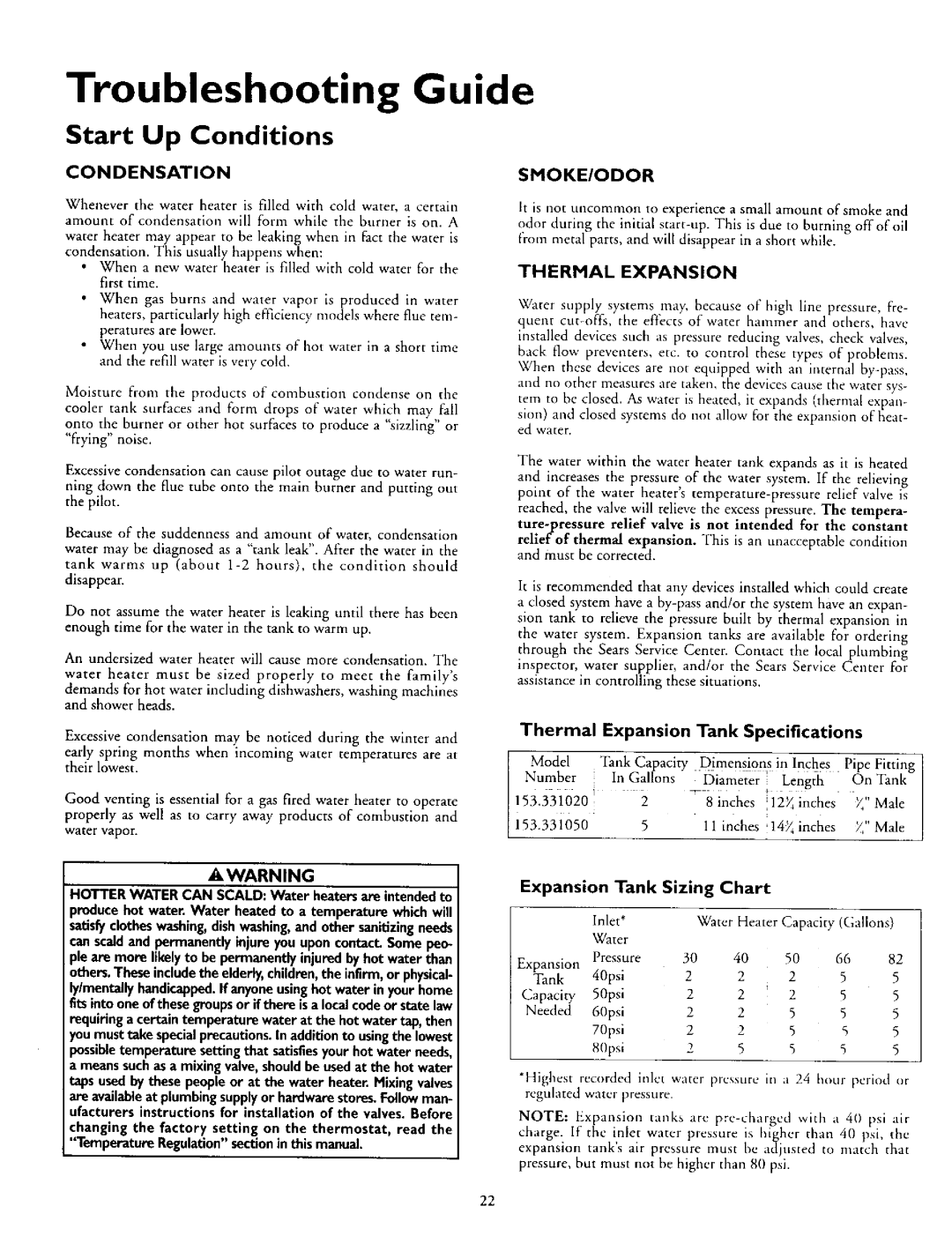
Troubleshooting Guide
Start Up Conditions
CONDENSATION
Whenever the water heater is filled with cold water, a certain amount of condensation will form while the burner is on. A water heater may appear to be leaking when in fact the water is condensation. This usually happens when:
•When a new water heater is filled with cold water for the first time.
•When gas burns and water vapor is produced in water heaters, particularly high efficiency models where flue ten> peratures are lower.
•When you use large amounts of hot water in a short time and the refill water is very cold.
Moisture front the products of combustion condense on the cooler tank surfaces and form drops of water which may fall onto the burner or other hot surfaces to produce a "sizzling" or "frying" noise.
Excessive condensation can cause pilot outage due to water run- ning down the flue tube onto the main burner and putting out the pilot.
Because of the suddenness and amount of water, condensation water may be diagnosed as a "tank leak". After the water in the tank warms up (about
Do not assume the water heater is leaking until there has been enough time for the water in the tank to warm up.
An undersized water heater will cause more condensation. The
water heater must he sized properly to meet the family's
demands for hot water including dishwashers, washing machines and shower heads.
Excessive condensation may be noticed during the winter and
early spring months when incoming water temperatures are at their lowest.
Good venting is essential for a gas fired water heater to operate properly as well as to carry away products of combustion and water vapor.
AWARNING
HOTTER WATER CAN SCALD:Water heatersare intendedto producehot water. Water heated to a temperature whichwill satisfyclotheswashing,dishwashing,and other sanitizingneeds canscaldand permanentlyinjureyouuponcontact.Somepeo- pleare more likelyto be permanentlyinjuredbyhot water than others.Theseincludethe elderly,children,the infirm,or physical- lylmeotally handicappedIf. anyoneusinghot water in your home fitsintooneoftbesegroupsor if there isa localcodeor statelaw requiring a certaintemperaturewaterat the hot watertap, then you musttake specialprecautionsIn. additionto usingthe lowest possibletemperaturesettingthat satisfiesyourhot water needs, a meanssuchas a mixingvalve,shouldbe usedat the hot water tapsusedby thesepeopleor at the water heater.Mixingvalves
are availableat plumbingsupplyor hardwarestores.Followman- ufacturers instructionsfor installation of the valves.Before
changing the factory setting on the thermostat, read the "Temperature Regulation"sectionin this manual.
SMOKE/ODOR
It is not uncommon to experience a small amount of smoke and
odor during the inltia[
THERMAL EXPANSION
Water supply systems may, because of high line pressttre, fie-
quent
When these devices are not equipped with an internal
sion) and closed systems do not allow for the expansion of heat- ed water.
The water within the water heater tank expands as it is heated and increases the pressure of the water system. If the relieving point of the water heater's
ture_ressure relief valve is not intended for the constant relier of thermal expansion. This is an unacceptable condition and must be corrected.
It is recommended that any devices insta ed wh ch could create a closed system have a
Thermal | Expansion | Tank Specifications | |||
Model | Tank Capacity | Dimensions in Inches | Pipe Fitting | ||
Number | In Gallons | Diameter | Length | On Tank | |
153.331020 | 2 | 8 inches | '12_ | inches | _" Male |
153.331050 | 5 | 11 inches | ' 14_ | inches | _," Male |
Expansion Tank Sizing Chart
Inlet*Water Heater Capacity (Gallons) Water
Expansion | Pressure | 30 | 40 | 50 | 66 | 82 |
Tank | 40psi | 2 | 2 | 2 | 5 | 5 |
Capacity | 50psi | 2 | 2 | ' 2 | 5 | 5 |
Needed | 60psl | 2 | 2 | 5 | 5 | 5 |
| 70psi | 2 | 2 | 5 | 5 | 5 |
| 80psi | 2 | 5 | 5 | 5 | 5 |
*Highest recorded inlet water pressure in a 24 hour period or regulated water presstne.
NOTE: Expansion tanks are
22
